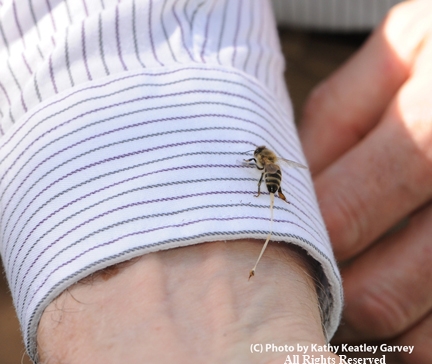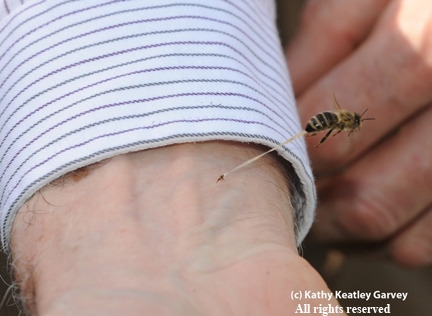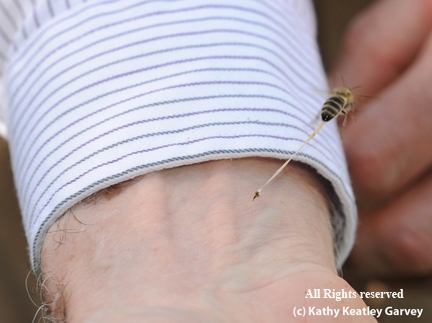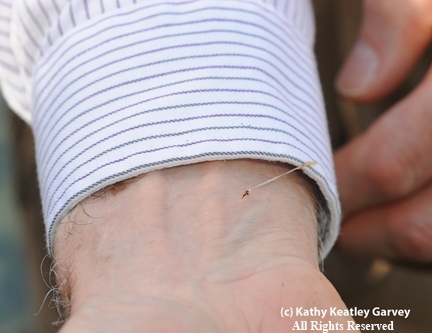I've been asked how I did it.
How did I manage to capture that rare image of a honey bee sting that won the feature photo award presented June 11 by the international Association for Communication Excellence (ACE)?
The bee is tugging a long strand of abdominal tissue as it tries to pull away. Most stings are a clean break. In fact, every bee sting I've ever had--about 15 or so--was a clean break.
Well, it all started at the Harry H. Laidlaw Jr. Honey Bee Research Facility, University of California, Davis.
It was the lunch hour. Extension apiculturist Eric Mussen, with UC Davis Department of Entomology, and I were checking out a hive when he casually said: "Kathy, get your camera ready. This bee is about to sting me."
I removed the lens cap and aimed my camera at the bee. The bee was NOT about to sting him--the bee WAS stinging him.
I shot four photos within a second. My camera can shoot as fast as eight frames a second. Settings: 640 ISO, 1/250 of a second, aperture of 13. Camera: Nikon D700, equipped with a motor drive and a 105mm macro lens.
For educational purposes, I posted the second photo of the sequence on the web. That's why I shoot: educational purposes. Soon people from all over the world were downloading it and using the photo (unauthorized) to sell medical products and the like. One person in Iraq even put his copyright on it.
Well, I thought, it must be an okay photo if folks are lifting it!
I entered "The Sting" in the 2012 feature-photo competition sponsored by ACE, a professional organization comprised of communicators, educators and information technologists in agriculture, natural resources, and life and human sciences.
To my surprise, it won the gold award in the feature category and then the Outstanding Professional Skill Award in Photography.
Mussen wrote about the awards in his newsletter, from the UC Apiaries. (And mentioned the other gold award, for best news writing.)
So, here I am today fielding questions about the photo after it appeared yesterday in the news media. "Amazing!" was the general consensus. However, two persons expressed outrage. One accused me of animal cruelty. Not so. The bee sting was unexpected; it was neither planned nor posed. In fact, I work on several fronts to help save the declining bee population, even going so far as rescuing bees from the pool and offering them a sip of honey.
One person thought I should have put the (insert colorful adjective here) camera down and helped "the poor guy getting stung."
Actually, the "poor guy" was the one who asked me to take the photo!
What most people don't realize is that getting stung by a bee is no big deal to beekeepers. It happens thousands of times throughout the country every single day. Sting? Yawn. So what else is new? Got any plans for the weekend?
What's good about this whole thing is that bee scientists can use the sting photo as an educational tool. Just got a call from one of them...
(Editor's Note: Like Bug Squad on Facebook)
Attached Images:

FIRST PHOTO--When honey bees sting, it's usually a clean break. Extension apiculturist Eric Mussen getting stung. (Copyrighted, All Rights Reserved, Photo by Kathy Keatley Garvey)

SECOND PHOTO--Honey bee pulling out abdominal tissue. This photo won the ACE feature photo award. (Copyrighted, All Rights Reserved, Photo by Kathy Keatley Garvey)

THIRD PHOTO--Honey bee trying to escape after stinging. Worker bees die after stinging, which usually occurs while they're trying to defend their hive. (Copyrighted, All Rights Reserved, Photo by Kathy Keatley Garvey)

FOURTH PHOTO--A strand of abdominal tissue. (Copyrighted, All Rights Reserved, Photo by Kathy Keatley Garvey)